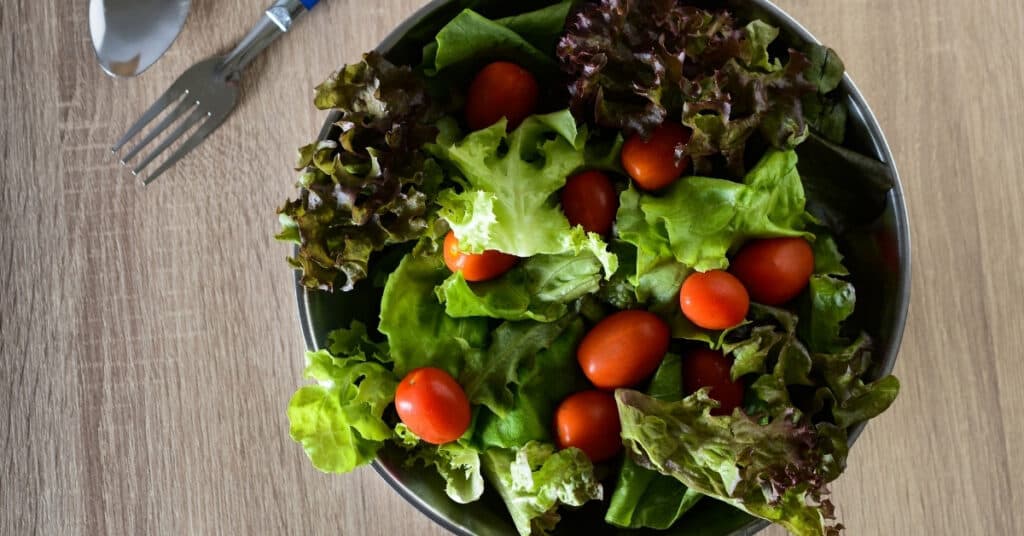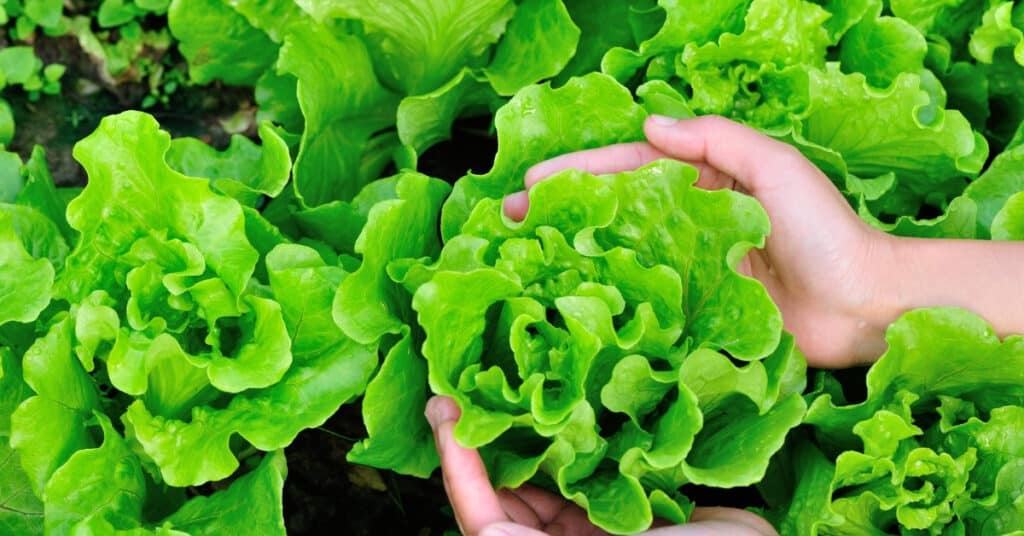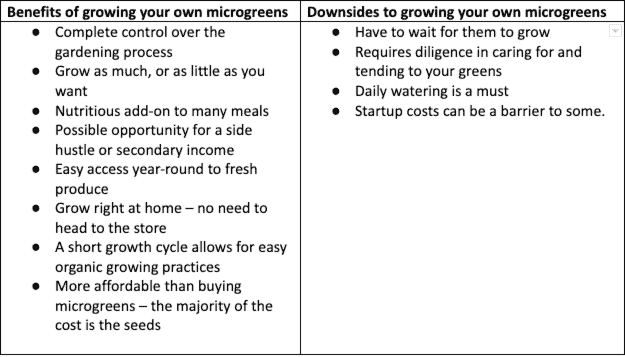In this post, you will find information on what microgreens are, all types of microgreens, how they benefit you, and the microgreen growing process.
The microgreen craze has swept supermarkets across the country. Microgreens are now a staple for many grocers. But there are so many types of microgreens out there; it can be difficult to distinguish between the most popular and most nutritious.
Because microgreens come in so many varieties, this complete guide has been curated to find the best and most popular microgreens and cover everything about microgreens, from eating to cooking to gardening.
In this post, you will find information on what microgreens are, the different types of microgreens, how they benefit you, and the microgreen growing process. By the time you get through this post, you’ll be a virtual expert on microgreens.
What Are Microgreens?
Microgreens are defined as the stage when a plant has sprouted and grown leaves, but it is not anywhere near full maturity. Using this simple definition, anything from seed can turn into a microgreen; it depends on when it’s harvested. Usually, microgreens are harvested 10-14 days after planting.
What Makes Microgreens Distinct from Other Types of Greens?
Microgreens are distinct from baby greens and sprouts. This is an important distinction to make because some packaging may be misleading or confusing. Here is some information to help distinguish between one green and another:
| Sprouts | Microgreens | Baby Greens | Greens | |
|---|---|---|---|---|
| Size: | Tiny | Small | Medium – almost mature | Large – fully matured |
| Stage in Normal Harvesting: | Germination | Cotyledon | Premature | Mature |
| Time to Harvest: | Right after germination | 10 to 14 days | Every few weeks | Every few weeks |
| Harvested from: | The root | The stem | The stem | The stem |
| Presence of Leaves: | No | Yes | Yes | Yes |
What distinguishes microgreens from other greens?
- Concentrated with nutrients
- Tiny leaves
- Leaves and stem harvested
- Less dense
- Fewer stringy stems
(Source: What Are Microgreens?)
Now that you have all the basics down about microgreens, you are probably wondering what types of microgreens are out there.
There Are Many Types of Microgreens
Because a microgreen is defined as a plant with leaves that is not much older than a sprout, almost any plant can be grown with the idea to harvest as microgreens.
The most popular varieties include:
- Watercress
- Wheatgrass
- Lettuces – Arugula, spinach, swiss chard, endive, radicchio, and kale
- Pea
Even though these are some very popular kinds of microgreens, there are still many other types out there. Since microgreen is defined the way it is, you can try so many different types of microgreens. And you can do so in a short amount of time if you are growing microgreens yourself.
Other varieties of microgreens:
- Squashes – Cucumbers and summer squash
- Grains – Quinoa, wheat, and barley
- Root vegetables – Beets and carrots
- Cruciferous veggies – Cauliflower, broccoli, bok choy, radishes, and cabbage
- Spices and herb – Dill, fennel, mustards, and celery
- Fruits – Melons
Because microgreens are so small, in addition, to being concentrated in nutrients, they are packed with flavor.
Flavor profiles of different microgreens:
- Spicy – Arugula, garlic radish, and onion microgreens
- Sweet – Carrot, pea, and melon microgreens
- Bitter – Radish, cabbage, and beet microgreens
- Neutral – Watercress and most lettuce microgreens

Now flavor profiles are very dependent on the variety of plant you choose. Since the flavor is concentrated, if you’ve grown your seeds to maturity, you’ll have an idea of the microgreen’s flavor. If you have bought new seeds, it’s time to experiment and find your favorite type of microgreen!
(Source: Types of Greens)
The Most Popular Microgreens and Their Growth Cycles
Most microgreens germinate within a few days and are ready to harvest in a week or two. This information and their flavor profiles microgreens are listed in the table below:
| Microgreen | Days to Germinate | Days to Harvest | Flavor Profile |
|---|---|---|---|
| Radish | 1-2 days | 5-10 days | Spicy and crisp |
| Beetroot | 3-4 days | 10-12 days | Earthy and beet-like |
| Arugula | 2-3 days | 5-7 days | Peppery and spicy |
| Carrot | About 7 days | 4 or more weeks | Very carrot-like, sweet |
| Peas | 3-5 days | 8-12 days | Sweet and pea-like |
| Amaranth | 2-3 days | 8-12 days | Similar to spinach |
| Mustard | 3-4 days | 6-10 days | Zesty and spicy |
| Alfalfa | 3-5 days | 8-12 days | Mild and crunchy |
| Kale | 3-5 days | 8-12 days | Similar to romaine or other lettuce |
| Collard greens | 3-5 days | 10-12 days | More intense flavor than full-grown greens |
Most microgreens are bested used as garnishes, in salads, or in sandwiches. You can replace any full-size green a recipe calls for with microgreens. Most prefer microgreens to full-size greens for their milder flavors.
(Source: Popular Microgreens)
Where Can I Buy Microgreens?
There are many places where you can get microgreens. Now that they have become a health and diet food craze, you can get them almost anywhere you buy your produce.
Microgreens are available at:
- Grocery stores
- Large retailers
- Farmer’s markets
- Online shopping and farming services
In addition to being readily available where you buy your produce, the amount of money you spend on microgreens can differ significantly. Depending on availability, time of year, and the region you live in, pricing can change frequently.
Potential spending on microgreens:
- Costs vary depending on freshness and variety.
- Popular, quality microgreens will end up costing you more.
- Farmer’s markets offer access to fresh and relatively low-priced greens.
Because microgreens can be expensive to buy at the store, growing them yourself is a great option. Growing also gives you the flexibility of when to harvest, which gives your microgreens a longer shelf life. We’ll talk more about this later on.
Are Microgreens Healthier than Other Greens?
There is a lot of science that backs the notion that microgreens have more nutrients and are healthier for you. Many scientific studies have compared mature, sprout, and microgreen nutrient levels. Microgreens are healthier because:
- They are more nutrient-dense – Mature leaves have fewer nutrients.
- There are more than 25 options – Variety allows you to find your favorite type.
- They are rich in antioxidants – Most vegetables contain these properties but have lower antioxidants levels than microgreens.
(Source: Microgreens and Nutrients)
Even though many studies tout high nutrient levels, nutrients can vary widely depending on the plant and growth cycle. Some studies counter this point, saying mature leaves have the same, if not more, nutrients.
Overall, microgreens are deemed healthier compared to other types of greens. Keep in mind that vegetables, in general, are good for you and your body. Any number of veggies is a good thing, no matter the type.
Benefits of Eating Microgreens
There are lots of benefits to eating microgreens. Chief among them is that they are healthy food; some may even call them a superfood.
With increased nutrient uptake from adding microgreens to your diet, you may notice:
- Improved eyesight
- A better, happier mood
- Regular digestion
- Less bloating or heaviness
Nutrients can be hard to incorporate into your everyday diet.
Nutrient-dense microgreens solve the problem of nutrient deficiencies by providing you simple, easy access to greens that can be added to just about any recipe.
What to Do with Microgreens
With all types of microgreens, there are a few options readily available to you. If you are trying to decide what to do with microgreens and how they fit into your lifestyle, these points are for you. Microgreens are a simple, low-intensity gardening add-on.
Microgreens from your garden can be:
- Grown year-round. Meaning consistent access to these fresh greens
- Eaten. Yummy, flavorful, fun garnishes, or salad add-ons
- Sold. Depending on the size of your growing operation, you may make a profit.
In the next few sections, you can find information specific to each of the points mentioned above. Growing, eating, and selling microgreens all have different benefits and downsides.
Growing Microgreens
Being able to grow your own microgreens may be a game-changer for you.
Growing microgreens at home give you the opportunity for year-round, simple, and low-cost access to nutrient-dense, flavorful greens.
Because you are growing them, you can harvest them fresh and as needed. This flexibility will save you a lot of money and keep you from having to throw away a half-eaten bag of greens that have gone bad.
Microgreen Starter Kits
Microgreen starter kits are very popular options for the novice gardener. They may also be a great choice if you want to get an operation up and running fairly quickly.
The most popular types of greens to start growing:
- Wheatgrass – For all the health nuts or animal lovers
- Lettuces – For a simple replacement to bagged salad mix
- Watercress – An all-around staple in the microgreen community
Options for Microgreen Starter Kits
Choosing between starter kits can be quite a daunting task, especially if your level of gardening expertise or plant health is minimal. Below are three options in multiple price ranges that will help you get started in growing your microgreens.
High-End Option: HAMAMA Home Microgreens Growing Kit
- Ready to eat in 7 days
- Easy set-up – just add water
- Set it and forget it
- Guaranteed to grow, or get your money back
Mid-Priced Choice: Grow ‘n Serve Microgreen Kit
- Multiple seed options
- Multi-use trays
- Spray bottle and soil included.
Budget Buy: Window Garden Indoor Microgreens Seed Starter
- Multiple seed options
- Soil and seeds included
- Simple instructions
- Ready to eat in 10 days
- Great for experienced or novice growers
Now that you have got all the options for starter kits, are you ready to get growing? If you are still skeptical about why you should grow your own greens, the benefits outweigh the disadvantages.
Why You Should Grow Your Own Microgreens
Growing your own microgreens allows you to have complete control over the growing process. And that is not the only benefit. There are many other advantages to growing your own microgreens inside your home or in your garden.


Maybe you are not sold on using a starter kit for growing microgreens. Below you’ll find a step-by-step guide on growing microgreens without a starter kit.
How to Grow Your Own Microgreens Without A Kit
Just because there are options for starter kits, if you have a little more time or you’re familiar with gardening, you can choose to opt for just buying seeds instead of a whole starter kit. Only six simple steps and four essentials make growing your own microgreens a reasonable undertaking.
Materials needed to grow microgreens:
- Large or small, shallow tray
- Seeds for sprouting
- Window or grow light
- Grow mats, or soil
Steps to growing microgreens:
- Fill your tray halfway full of soil and dampen with water, but don’t oversaturate.
- Place seeds in an even layer and press gently into the soil.
- Top with enough soil to just cover the seeds.
- Dampen the top layer of soil and be careful not to overwater.
- Move to a windowsill, near natural sunlight, or under a grow light.
- Water every day. Make sure not to oversaturate. Too much water or moisture can cause mold (which you want to avoid).
Storing Your Microgreens
Storing your microgreens is just as important as growing your greens. There are a few things to consider in the storage process.
Three ways to store microgreens:
- The Good way – Store in the fridge for anywhere between ten days and two weeks
- The Better way – Harvest as they grow and store in the fridge; use within a few days
- The Best way – Wait until you are ready to use them, then harvest as needed.
Scenarios to avoid:
- E. coli contamination – Choose a soil medium, environment, and water carefully; wash greens before consumption
- Moldy soil – Water, so soil and plants stay hydrated but not overly saturated; avoid extra humid environments
(Source: Microgreen Risks)
Lastly, before we dive into all things edible, here are some final quick tips for the growing and storing process.
Other considerations to keep in mind:
- Pick a sunny space – Whether it’s by a window or under a grow light, plants need light to thrive.
- Always store greens in your fridge – Avoid contamination and keep bacteria away for more extended periods of time by keeping them chilled until use.
- Always wash any greens before consumption – keeps you safe; wash only enough to eat when you are ready to eat them, to avoid your microgreens getting moldy or slimy while in the fridge.
Need More Advice on Growing Microgreens?
If you are a little unsure about getting your growing practice started, seeking out more advice may be helpful.
Who to talk to about microgreens:
- Community garden managers – They have a lot of expertise in all types of growing; bonus if you catch them at your farmers market selling microgreens.
- Again, local farmers are experts in what they do; you may find a microgreen farmer right in your backyard.
- A nursery employee – Usually know plants they sell; always ask, you never know what you’ll find out.
Other ways to learn how to grow microgreens:
- Reading – Books provide great visuals and personal stories.
- Videos – Free and easy to follow along
- Take a class on gardening – many nurseries offer gardening classes.
In any experience, coming prepared with questions will help you get the most out of your practice. Now you have some idea of growing and storing your microgreens; it’s time to eat them!
Eating Microgreens
As mentioned previously, eating microgreens is the best part! There are many options to determine how you want to go about eating your greens.
Quick and Easy Recipe Ideas
The internet is home to tons of recipes that call for microgreens. Especially since they have become a staple in the diet and health food industries, you can find nutritious and tasty recipes at your fingertips.
Ideas to get you started for using up your microgreens:
- Sprinkle over your favorite dish as a garnish
- Mix into your mashed potatoes for added flavor and nutrients
- Dress with a bit of olive oil and lemon juice for a quick salad
- Use in place of mature greens in your favorite pesto recipe.
- Try them blended into a fruit or veggie smoothie.
In addition to the wealth of knowledge on the internet, there are some great recipe books out there specifically about microgreens.
Microgreen Recipe Books
While there are unlimited online resources for finding microgreen recipes, some of the best books you can buy on microgreens are below.
A comparison of microgreen recipe books:
| Pros | Cons | |
|---|---|---|
| The Microgreens Cookbook | Great visualsEasy to prepare recipesFocused on cooking with microgreensGreat for learning about the soil and sun growing processRecipes for all eaters | Best for microgreen growersNot the best for learning about microgreensNot for learning about hydroponic greens |
| Eat Now! 15 Savory Microgreen Books Series | Three booksRelatively low costSimple, delicious recipesGreat for microgreen beginnersOver 40 recipes total | Vague statements about healthVisuals are generic |
| The Microgreens Recipe Book | Elegant and cheap recipesGreat for those interested in finding different ways to cook microgreens | Only ten recipesAppears to be self-published |
These are only a small selection of the recipe books out there specifically for microgreens. If you are interested in reading more about growing microgreens, there is so much to read.
Further Reading on Microgreens
If you want more information, additional perspectives, or another medium for learning, books are a great way to find information, and most happen to include great visuals. Below are three synopses to entice you into further reading.
- E-book, paperback, and audio versions
- Published in 2020
- Info on optimizing your growing operation
- Expertise on a successful microgreen farmer
- Bonus recipes
Microgreen Garden: Indoor Grower’s Guide to Gourmet Greens
- E-book and paperback options
- Focus on indoor growing
- Instructions for enhancing your greens’ growth
- Covers small and large scales
Microgreens: How to Grow Microgreens for Fun or Profit
- E-book and paperback available
- Problem-solving techniques
- Growing your business by improving marketing
All three books are available today for a low cost, and each one has excellent reviews. If the internet doesn’t have all your looking for, these books certainly will.
Selling the Microgreens, You Grow
Finally, selling microgreens is the last thing you can do with your microgreens. And this can be a very lucrative business if you want it to be. People love fresh greens!
Selling requires you to have a more extensive grow operation. Keeping that in mind, selling your microgreens is not a passive income, because you have to spend time tending to your seedlings and marketing your business.
Turning Your Operation into a Profit
Profiting from selling microgreens most likely will not happen overnight. Creating a small business, side-hustle, or second income can be hard work.
Selling your microgreens requires two things:
- Time – Selling greens will require you to get your “face” out there, be that at farmer’s markets or on social media
- Investment – Most businesses require startup costs, and this is no different
If you have time and money, you’re ready to get started with building your new business. Selling microgreens is not much different from any other business. But if you are new to gardening, it may be best to see how easy growing is for you before you sell.
How to Sell Microgreens
The biggest thing to worry about with selling microgreens is that your product has a short shelf-life. Microgreens lose freshness and continue to decline as soon as they are harvested.
A workaround for this would be for you to sell squares of soil, and people would be able to harvest themselves. This would increase costs because it requires you replenishing resources more frequently.
Five steps to selling your microgreens:
- Set up your equipment in a space that you will be able to easily scale-up if desired.
- Plant your seeds. (See growing your own microgreens above.)
- Once plants have grown, determine where and when you will sell them.
- Harvest and wash greens. Allow them to dry before selling.
- Sell the heck out of your greens!
Once your microgreens are grown, they will most likely sell themselves.
Where to Sell Microgreens
Depending on the scale of your operation, there are a few different options for selling microgreens. Similarly, where you can buy microgreens, you can sell them in the same places.
You can sell your microgreens at:
- A regional farmer’s market – Usually, there is an application process, and spots fill up quickly.
- Your local grocer – Mom and Pop shops love highlighting local business because it is mutually beneficial.
- Big box stores – Some chain grocers stock locally made or grown products; check-in with these chains’ purchasers.
- Get creative – Facebook marketplace, or through any online group, may be just the opening in the market you need
Running a New Business
Selling microgreens may not be an easy undertaking for everyone. You may have to deal with specific issues as they arise.
Things to keep in mind with your new side hustle:
- Profits take time
- Being an expert goes a long way in talking up your product.
- Keep greens chilled as much as possible – you don’t want them wilting before you sell them.
- Social media provides many great platforms to sell or talk up your business.
- You get out what you put into a business.
- Your passion shines, use it.
Having a side hustle is not for everyone, but if you love growing microgreens and are a great gardener, it may be the perfect opportunity for you to earn some money.
Are There Downsides to the Microgreen Movement?
The microgreen movement is part of the health and diet trends that consistently sweep the media. This may put some people off from the microgreen movement.
Overall, there are no downsides to the microgreen movement. Incorporating microgreens into your lifestyle will make you healthier and provide you with nutrients you may be lacking.
So, What Are the Best Options for Microgreens?
Depending on your experience with growing and familiarity in the kitchen, your choice or preference within all the different types of microgreens may change. Many options may or may not give you the result you desire, so a breakdown of these choices is below.
Best microgreen for the beginner: Lettuces, radishes, and wheatgrass
- All microgreens are low maintenance; only require daily watering.
- Neutral flavor
- Seeds available from most garden centers
Best tasting microgreen: Personal preference wins here
- Microgreens with a neutral flavor can go with anything
- Usually, if you like the fully mature plant, you will enjoy the microgreen
Most flavorful microgreen: Tied between spicy and sweet varieties
- Spicy microgreens add flavor to savory dishes.
- Sweet microgreens could make an appearance on your dessert plate.
Best microgreen for cooking: Neutral varieties
- Neutral microgreens can go with anything
- They are great as a garnish, in a salad, or mixed in with your main dish.
Easiest to way to grow microgreens: Using a starter kit
- Quick and easy set up.
- Higher investment
- Most kits come with reusable trays and other equipment.
Fastest growing microgreen: Dependent on your care and the type of green
- Can be impacted by the amount of water, temperature, humidity, sunlight, or soil nutrients and more
- Seeds can be finicky because of the factors above.
- Many only take a few days to sprout.
- Sprout to microgreen growth times can vary widely.
- Must be provided with the right care to thrive
Summary
Microgreens are not just good for you, there are so many versatile options, and they are great for the new gardener. You can grow, eat, or sell microgreens, and each activity benefits your life in some way. Microgreens have a place in everyone’s home.
Because microgreens are packed with nutrients, there is no reason to not at least try them. And because there are so many kinds of microgreens, you are bound to find one that suits your palate.

